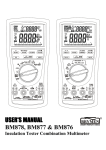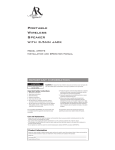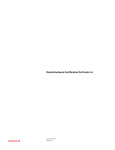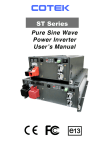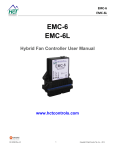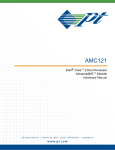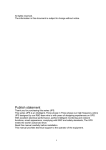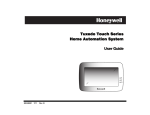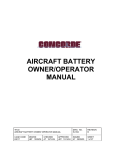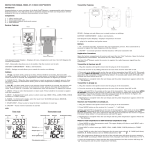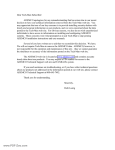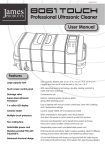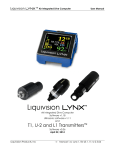Download instantaneous water heater instruction and installation manual
Transcript
INSTANTANEOUS WATER HEATER INSTRUCTION AND INSTALLATION MANUAL 3-48 kW 54-144 kW YOUR DISTRIBUTOR: Chemical Distributors, Inc. PHONE: 716-856-2300 • 800-777-2436 • FAX: 716-856-7115 80 Metcalfe Street • BUFFALO, NEW YORK 14206 U.S.A. [email protected] www.cdibuffalo.com 1 YOUR DISTRIBUTOR: Chemical Distributors, Inc. 80 Metcalfe Street Buffalo, NY 14206 PH: 716-856-2300 www.cdibuffalo.com © COPYRIGHT 2001 Process Technology, Inc. All rights reserved. Any reprinting or unauthorized use without written permission of Process Technology, Inc. is expressly prohibited. The information in this manual has been carefully checked and is believed to be accurate; however, no responsibility is assumed for omissions or inaccuracies. All information in this document is subject to change without notice. This document contains proprietary information and is subject to the conditions that the information: ♦ Be retained in confidence. ♦ Not be reproduced or copied in whole or in part. ♦ Not be used or incorporated as part of any product except under an express written agreement with Process Technology, Inc. This document is available on cleanroom paper. Contact Process Technology Inc. to order place HCT specific label here 2 PREFACE SAFETY SYMBOLS AND THEIR DEFINITIONS Take time to review these symbols and their meaning. They are used throughout this manual to serve as a notification of potential hazards, damage and/or injury. While the notification cannot eliminate a hazard, a considered understanding of a specific hazard and a proper course of associated activity will assist in improving accident prevention. DANGER Used to indicate an imminent hazardous situation which, if not avoided, will result in death or serious injury. DANGER SYMBOL WARNING Used to indicate a potentially hazardous situation which, if not avoided, could result in death or serious injury. WARNING SYMBOL 3 PREFACE CAUTION Used to indicate a potentially hazardous situation which, if not avoided, may result in injury, or an alert against an unsafe practice. CAUTION SYMBOL ATTENTION Used to direct operating or installation personnel to a correct course of action. ATTENTION SYMBOL 4 PREFACE RELATED DOCUMENTS The following documents are to be used in conjunction with this manual: ANSI/NFPA 70 - National Electric Code®, latest edition. To be used in conjunction with electrical service, wire sizing, routing and protection. SEMI S2 - Semiconductor Equipment Safety Guideline, latest edition. To be used in conjunction with safe operation, access and decommissioning procedures. DSL Instruction Manual, latest edition. To be used in conjunction with accessible features of the DSL temperature control. (Secure appropriate manual for any optional temperature control used in place of the DSL.) ANY state or local building codes that would cover the electrical, mechanical or physical installation of electric heating equipment. National Electric Code® NFPA 1999 Copyright National Fire Protection Association Quincy, Mass. 02269 5 PREFACE LIST OF ILLUSTRATIONS Overall View of the H2OT SHOT..................................................cover System Nameplate...........................................................................7 Heating Element Cutaway..................................................................10 Solid State Relays............................................................................11 View of the H2OT SHOTs.................................................................12 DSL Control...................................................................................... 13 Differential Pressure Switch............................................................13 Cool Down Solenoid........................................................................ 13 Mounting Hole Locations 3 element HCT.......................................................................15 9 element HCT.......................................................................15 Orifice Assembly..............................................................................18 Plumbing Connections.......................................................................19 Circuit Breaker...................................................................................20 DSL Functions...................................................................................22 System Front Panel.........................................................................22 Control Terminal Block......................................................................31 Differential Pressure Switch Adjustment.........................................31 Orifice Assembly................................................................................32 Orifice Assembly Supply Side..........................................................32 Orifice Assembly Outlet Side...........................................................32 Orifice Plate.......................................................................................32 O-rings................................................................................................32 GFP Test Button..............................................................................34 Duplex Filter (Strainer) Layout.........................................................36 3 element HCT Components...........................................................37 9 element HCT Components...........................................................38 6 RECEIVING INSPECTION It is imperative that the H2OT SHOT be examined for any shipping damage upon receipt. Although the typical damage may be “shake loose” damage only, any significant structural damage must be noted with the delivering carrier, as expensive and time consuming remedies may result. Verify that the unit specifications, found on the H2OT SHOT data tag (see illustration on left) agree with your purchase order. Any discrepancies should be brought to the attention of your purchasing department for immediate correction. If problems are encountered with the H2OT SHOT, verify that all applicable instructions have been followed properly and that they are consistent with the application and operating parameters. SYSTEM NAMEPLATE CONTACTING PROCESS TECHNOLOGY If problems persist, call Process Technology for technical assistance at (800) 621-1998 (U.S./Canada), or (440) 946-9500 (Outside U.S./Canada). Have the following information available: ♦ Model Number ♦ Serial Number ♦ Detailed description of the problem ♦ Application specifics such as: flow rates, inlet and outlet temperatures, and cycle times A Technical Sales staff member will analyze the problem and provide a course of action to return the unit to operation. If, after analyzing the problem an acceptable solution cannot be implemented, or if the repairs require factory attention, the Tech Sales staff member will issue a Return Material Authorization (RMA) number. The RMA number is for the return and evaluation of the H2OT SHOT or suspect component(s). Display this RMA number on the outside of the shipping container when returning to Process Technology. Every effort is made to evaluate returned H2OT SHOTs within 24 hours of receipt. Items returned to Process Technology for any reason SHALL BE VIA FREIGHT PREPAID, unless alternate, prior arrangements have been made. All materials must be cleaned and neutralized to remove all traces of any chemical deposit. The identity of any substance used in the H2OT SHOT must be divulged, and corresponding material safety data sheets (MSDS) must be returned with the unit. A H2OT SHOT needing to be returned must be sent to Process Technology’s Mentor, Ohio, USA location: Process Technology, Inc. 7010 Lindsay Drive Mentor, OH 44060 USA Re: RMA# 7 CONTENTS PREFACE Safety Symbols and Their Definitions...................................... 3 List of Related Documents........................................................ 5 List of Illustrations... ................................................................... 6 Receiving Inspection....................................................................7 Contacting Process Technology...................................7 1.0 Overview 1.1 General Specifications....................................................... 9 1.2 Principles of Operation.......................................................10 1.3 Controls and Safeties..........................................................13 2.0 Installation 2.1 2.2 2.3 2.4 2.5 Mounting...............................................................................14 Tightening Torques..............................................................16 Mechanical...........................................................................16 Electrical...............................................................................19 PreStart Testing...................................................................21 3.0 Operation 3.1 3.2 3.3 3.4 3.5 Description of Controls......................................................22 Start Up.................................................................................24 Shutdown.............................................................................25 Alarm/Fault Conditions.......................................................25 Non Alarm Conditions.......................................................25 4.0 Troubleshooting 4.1 System Not Heating............................................................26 4.2 Heating Element................................................................27 4.3 Solid State Relay................................................................28 4.4 DSL Output Signal.............................................................29 4.5 Continual Overheating.......................................................30 5.0 Maintenance 5.1 5.2 5.3 5.4 Adjusting the Differential Pressure Switch......................31 Changing the Orifice Plate................................................32 Testing the GFP...................................................................33 Heating Elements...............................................................34 6.0 Components 6.1 3 and 9 Element HCTs.......................................................37 Spare Parts.....................................................................................39 Index....................................................................................................40 8 OVERVIEW 1.0 OVERVIEW 1.1 GENERAL SPECIFICATIONS ATTENTION This user’s manual provides information necessary for the correct and safe operation of the Process Technology H2OT SHOT. Compliance failure can result in property damage and personnel injury. Model Electric Instantaneous Water H eater H 2OT SH OT ((H Se HC CT Sreie rs i e) s ) In-li ne heater for si ngle pass systems wi th reci rculati ng opti ons avai lable System Heater Power 3-144 kW Temperature Regulati ng Accuracy ±1°F (±1°C ), dependent upon operati ng condi ti ons Temperature Li mi t 185°F (85°C ) Flow Rate Ranges 3 - 48 kW Models: 1-15 gpm (3.8 - 57 lpm) 54 - 144 kW Models: 4-17 gpm (15 - 64 lpm) For hi gher flow rates consult factory. Maxi mum Operati ng Pressure 100 psi g (7030 g/cm3) Temperature C ontroller Mi cro-processor based PID controller, factory pre-set Fi ri ng C i rcui t Zero cross, burst fi red, soli d state relays (SSRs) Temperature Sensor Type J thermocouple Heati ng Element Ti tani um tubular heati ng elements i nsi de ti tani um contai nment tube (Stai nless Steel constructi on also avai lable, consult factory) Materi al of Wetted Parts Grade 2 C P ti tani um, PVD F, FEP, Vi ton, T316 Stai nless Steel Inlet/Outlet C onnecti ons ¾” MNPT standard, custom connecti ons avai lable Performance Specifications C omponents and C onstruction Emergency Operator Stop Swi tch (EMO) Hi gh process temperature alarm Safety Functions Low flow heater cutout Element sheath overtemp thermostats Mai n ci rcui t breaker; GFP standard on 3-48kW models, opti onal on 54-144kW models Pow er Supply 208-600 VAC , 3F (1F and custom voltages avai lable) 9 OVERVIEW 1.2 PRINCIPLES OF OPERATION The H2OT SHOT is a uniquely designed, compact, self-contained unit that heats water or process chemistry on demand. It is specifically designed to minimize fluid holdup volume and provide a clean, non-contaminating flow path for high purity processes. Titanium Outer C ontainm ent Shell H igh Velocity, Low Volum e W ater C h am ber Titanium Tubular H igh Energy H eating E lem ents C utaw ay View of H eating Elem ent The low volum e of w ater heated by the H igh Energy elem ents requires a reliable inlet water supply at all tim es. 10 OVERVIEW When properly installed, the H2OT SHOT senses flow rate using a differential pressure switch to sense the presence of a pressure drop across an orifice plate. When the preset pressure drop is reached, the heater firing circuit is enabled, allowing the heaters to energize. As the fluid travels through the outer containment shell (approx. 118 inches [3 m] in length), it is heated to the desired heat setting. Small differences in flow rate that could change the outlet temperature are regulated to within +/- 1° F (+/- 0.5°C) by the DSL temperature controller. Whenever the flow rate falls below the preset minimum, the H2OT SHOT switches to a standby mode and a small amount of fluid is discharged to a drain to permit the heating elements to cool down. WATER COOLED SSRs WARNING Shutting off water flow to the H2OT SHOT while in operation prevents element cool down and creates a super heated steam in the heating element. Customer fitting failure and damage to the solid state relays may result. At the end of this cool down cycle, the H2OT SHOT switches to a standby mode until the design flow rate is achieved and the heating mode is started. With multiple flow rate models, multiple pressure switches or a precision differential pressure transducer with appropriate signal conditioners are used to detect 2 or more flow rates and a below minimum flow rate to initiate the cool down cycle. AIR COOLED SSRs The basic H2OT SHOT incorporates 3 tubular heating elements while larger versions have 9 elements. Single element models are used where low flow rates (less than 1 GPM/4 LPM) are required. In special applications, a basic H2OT SHOT can be coupled to a single element model to accommodate very low and/or high flows. Solid state relays regulate the power level to the H2OT SHOT and are normally water-cooled. Air-cooled SSRs are necessary whenever the inlet fluid temperature exceeds 90° F. 11 OVERVIEW H2OT SHOT models 3-48 kW are comprised of 2 enclosures, one on top of the other. The upper enclosure is the control module and houses the majority of the electrical components. 3-48 kW H2OT SHOT H2OT SHOT models 54-144 kW are comprised of 2 enclosures, one behind the other, connected with a hinge. The front enclosure is the control module and houses the majority of the electrical components. 54-144 kW H2OT SHOT 12 OVERVIEW 1.3 CONTROLS AND SAFETIES TEMPERATURE CONTROLLER The control of the H2OT SHOT resides in two components, the DSL temperature controller and the differential pressure switch (or the alternate flow detection method). The temperature controller senses the outlet temperature, compares that value to the set point and adjusts the firing rate of the solid state relays to provide the required power level to achieve (maintain) the required temperature. The DSL control also contains the high temperature alarm set point. This is factory set for safety. If the outlet temperature exceeds the factory set point, the main heating contactor will open, removing heating power and sounding the alarm. The differential pressure switch senses pressure drop (which is proportional to flow rate) across a specified orifice plate. When the pressure drop (flow rate) achieves a predetermined level, power is applied to the heating elements via the solid state relays. When the pressure drop (flow rate) falls below this predetermined level, power to the solid state relays is removed and a timed cool down cycle is initiated. The cool down cycle consists of approximately 1 gallon (3-4 liters) of water flowing through the cool down solenoid to a suitable drain site. COOL DOWN SOLENOID VALVE The cool down solenoid is also actuated if the outlet temperature sensed by the DSL control exceeds the set point value by 10° F (5° C). This feature moderates the outlet temperature in a momentary low flow condition. Situated on the H2OT SHOT heating element are three bimetallic overtemperature safety switches. If the heating element exceeds the factory set point, the main heating contactor will open, removing power and sounding the alarm. DIFFERENTIAL PRESSURE SWITCH Most H2OT SHOTs are equipped with electrical ground fault protection (GFP). A typical mode of failure for electric heating elements is shorting to ground. If the GFP detects a fault leakage, it will open the main circuit breaker or main heating contactor. T D A N GER The H 2OT SH OT ground fault circuitry (GFP) is for detection of heater element failure ON LY. The GFP will N OT afford shock protection for personnel. 13 INSTALLATION 2.0 INSTALLATION 2.1 MOUNTING On H2OT SHOT models 3-48 kW, mounting holes are located on the rear panels of the upper and lower enclosures. ♦ Do not install the unit in an atmosphere where it will be exposed to corrosive gases, explosive vapors, temperatures above 104° F (40° C), or humidity above 90% (non-condensing). ♦ Ample clearance must be provided around the H2OT SHOT in the event that service or maintenance must be performed. Due to the need for a drain for the cool down cycle, fluids may require special disposal methods which may affect placement of the unit. ♦ Examine your proposed mounting surface and assure that it is capable of supporting the weights indicated for the H2OT SHOT. 55 lbs. (25 kG) for H2OT SHOT 3-48 kW 110 lbs (50 kG) for H2OT SHOT 54-144 kW Access to the interior of the upper and lower H2OT SHOT enclosures is gained by rotating the circuit breaker (or disconnect) handles counterclockwise slightly past the OFF position and turning each of the cover latches 1/4 revolution with a flat-bladed screwdriver. Mounting holes are located at the extreme corners. On H2OT SHOT models 54-144 kW, mounting holes are located in the rear enclosure. The front enclosure is accessed by rotating the circuit breaker handle slightly past the OFF position and turning each of the cover latches 1/4 revolution with a flat-bladed screwdriver. To access the rear enclosure, insert a flat bladed screw driver into the release latch located on the right side of the internal electrical panel and swing the electrical panel outward. Power connections are made to the rear enclosure via an umbilical cord that exits through the back of the control module. Care should be taken to avoid damaging this umbilical cord. Note the mounting bolt hole locations on the back panel. These will be used to locate and secure the H2OT SHOT to a surface capable of supporting the weight of the specific model. 14 INSTALLATION 0 .5 " (1 3 m m ) 4 p laces 1 8 .5 " 470 m m 1 8 .5 " 470 m m 3 0 .6 3 " 778 m m 3-48 kW UNITS 2 8 .5 " 724 m m 54-144 kW UNITS MOUNTING DIMENSIONS Measure the four mounting hole locations on the H2OT SHOT rear panel and transfer these positions onto your mounting surface. Four 3/8" (10 mm) bolts are sufficient for structural support, provided it is mounted on a suitable structure. If the mounting surface is masonry, properly installed masonry anchors can be utilized. If you are unsure of the strenght of the masonry, use through-bolting with backing plates. Consult your local masonry contractor for assistance. Structural frameworks should utilize through-bolting (as opposed to tapped holes) . Once the H2OT SHOT is securely fastened to the mounting surface, carefully inspect for any loose wiring or loosened power terminal connections. Shake-loose damage may occur when the H2OT SHOT is subject ed to excessive vibration during transit. Electrical connections must be checked to ensure that the required tightening torque is still applied. 15 INSTALLATION 2.2 TIGHTENING TORQUES WARNING Improperly torqued electrical terminal connections will result in overheating and may result in a fire. TIGHTENING TORQUE FOR ELECTRICAL CONNECTIONS Contactors see data on contactor tag Heater Fuses 84 IN-LBS (9.5 Nm) Circuit Breaker see data on circuit breaker tag Power Terminal Blocks (white) 50 IN-LBS (5.6 Nm) Power Terminal Blocks (black) see data on terminal block body Once you arer assured that all of the terminals are properly torqued and that no loose wires (or parts) exist, proceed with the installation. 2.3 MECHANICAL The H2OT SHOT must never be used with flammable liquids. D A N GER The heating elements are capable of reaching a temperature in excess of 1385° F (750° C ) which may exceed the auto ignition temperature of many fluids and combustible materials. 16 INSTALLATION Flammable liquids may be heated indirectly using the H2OT SHOT in a closed loop system with an appropriate thermal transfer fluid and heat exchanger system. Consult the Technical Sales department at Process Technology if questions arise regarding the suitability of fluids for use in the H2OT SHOT. The H2OT SHOT requires a consistent minimum flow. That flow is determined by using the formula below. This value is also printed on the faceplate of the unit. Failure to supply sufficient flow may cause permanent damage to the equipment. 6.80 x (kW rating of water heater) Minimum gpm = ——————————————————(180-maximum inlet water temperature °F) -orkW rating of water heater Minimum lpm = ——————————————————(82-maximum inlet water temperature °C) WARNING Shutting off water flow to the H2OT SHOT while in operation prevents element cool down and creates a super heated steam in the heating element. Customer fitting failure and damage to the solid state relays may result. All flow control valves must be installed on the outlet side of the H2OT SHOT to ensure that the heater has full pressure and flow available at all times. Restricting flow on the inlet side of the heater will cause serious damage to the heating elements. A service valve on the inlet side of the unit should be installed and clearly labeled: “FOR SERVICE ONLY” 17 INSTALLATION The inlet water temperature to the H2OT SHOT must not exceed 90° F (32° C) unless the unit is equipped with optional air-cooled solid state relays. All plumbing must be designed to withstand an over-temperature event (>212° F/100° C), plus any safety factor specified by your system designer. Low temperature thermoplastic piping must NOT be used. Piping of titanium, stainless steel, PVDF, or PFA may be used at inlet and outlet connections. The H2OT SHOT is supplied with 3/4” MNPT fittings for inlet and outlet connections as standard. A minimum pipe size of 1/2” (13 mm) is recommended for flow rates up to 5 gpm (19 lpm). Unions or flange fittings are recommended to expedite removal for maintenance. ORIFICE ASSEMBLY The direction of flow through the H2OT SHOT is critical for proper performance. Refer to the indicating arrows on the heating element for proper flow direction. In the absence of the indicating arrows, you can determine the OUTLET connection by locating the ORIFICE ASSEMBLY. It is always located on the OUTLET side of the H2OT SHOT. Fluoropolymer tape is suggested as a pipe thread sealant. Clay-based pipe dope is not an acceptable sealant. Care must be exercised when engaging threaded fittings to the heater, as excessive torque can cause damage to the heater. Always secure the heater side nipple with a pipe wrench. Position this opposite to the tightening wrench in order to prevent tightening torque from being transferred to the heater. A 1/4” (6.35 mm) stainless steel compression fitting is supplied for connection to the cool down (bleed) system. Install 1/4” stainless steel tubing from this fitting to a zero back pressure disposal drain. The temperature of this cool down fluid will often exceed 100° C. Adjoining pipe materials must be able to withstand these temperatures. ATTENTION Cool down fluid temperature can exceed 100° C. 18 INSTALLATION After piping installation, it is recommended that the installed piping and the heater be thoroughly flushed with DI water to remove any contaminants that were introduced during installation. Inlet O utlet C oo l D ow n O u tlet Plum bing C onnections 2.4 ELECTRICAL It is recommended that a service disconnect be installed ahead of the H2OT SHOT. Verify that the voltage and service specified on the data tag meets your specifications. Survey the power line for transient energy and harmonic distortions that can be caused by phase angle firing circuits, electromagnetic interference (EMI) and radio frequency interference (RFI). These sources of interference can cause erratic control and premature solid state relay failures. Either correct the cause or provide line filters to minimize any power distortions. All H2OT SHOTs are energized and tested in the factory prior to shipment. The end user is responsible for the proper wiring of the unit. The National Electric Code (NEC), state, local, and other applicable codes must be followed. The recommendations which follow are not to conflict with the NEC or any other applicable code, but are to be a guide for field wiring of the H2OT SHOT. ONLY QUALIFIED ELECTRICIANS SHOULD BE PERMITTED TO PERFORM THE INSTALLATION 19 INSTALLATION DANGER The H2OT SHOT operates at voltages hazardous to personnel. Accidental or purposeful circuit energizing without proper precautions can be lethal. Copper wire rated for 75° C should be used for power connection between the service disconnect and the circuit breaker. Refer to the NEC, Table 310-16, for appropriate wire sizing. CIRCUIT BREAKER AND GFP Stranded wire and compression lugs are recommended for ease of installation and to minimize destructive heating that can occur when the connection torque loosens over time. Gasketed conduit connections and junction boxes are recommended to protect the H2OT SHOT from vapors, sprays, or drips. Flexible conduit or a jointed conduit must be used on 54-144 kW H2OT SHOT models due to the need for access to the heater module. Be certain to allow enough conduit and wire for a 90° opening of the control module. IEEE grounding recommendations should be followed, i.e. both a metal conduit/raceway and a “green ground wire” be installed. Verify ground impedance per NEC Sec. 250-84. With the above installation instruction completed, the H2OT SHOT is ready for initial start-up procedures. 20 INSTALLATION 2.5 PRE-START TESTING Prior to placing any H2OT SHOT into operation preform the following: ♦ ♦ ♦ ♦ ♦ Verify electrical voltage. Verify water source pressure and flow rate. Verify destination piping. With power disconnected at the service disconnect and the H2OT SHOT enclosure open, open the flow control valve and allow water to flow through the heater. Crackling and popping noises are an indication that trapped air is being flushed out of the unit. Cycle the flow off and on several times to remove all air from the heater. Close the outlet flow control valve to pressurize the unit. Verify that no leaks exist. Close the H2OT SHOT enclosure. DANGER The H2OT SHOT operates at voltages hazardous to personnel. Accidental or purposeful circuit energizing without proper precautions or with enclosure open can be lethal. ♦ ♦ With the circuit breaker and the power toggle switch OFF, turn ON the service disconnect. Turn ON the circuit breaker. Turn ON the power toggle switch. The audible alarm will annunciate and the power-on and safety-on lights will be illuminated. Depress the start/reset push button and verify that the audible alarm is silenced. TURN OFF POWER AT THE POWER TOGGLE SWITCH, CIRCUIT BREAKER AND SERVICE DISCONNECT The above procedure verifies the serviceability of the installation. 21 INSTALLATION 3.0 OPERATION 3.1 DESCRIPTION OF CONTROLS DSL CONTROLLER A ud ib le A larm C ircu it B re aker D is co n n e ct H a n d le P o w er To g g le sw itch S ta rt/R e s e t E m erg en cy S top b u tton SYSTEM FRONT PANEL 22 OPERATION DSL CONTROL Displays: current outlet temperature PV-upper display; set point value SV-lower display; displayed temperature units °F or °C; power applied Set Point 1 Lamp; over-temperature alarm Alarm Lamp; plus access to review or change factory settings (refer to DSL Manual provided separately). AUDIBLE ALARM HORN Annunciates whenever the H2OT SHOT power contactor is open. Requires a START/RESET action on initial start up, or a corrective action followed by a START/RESET (following any alarm condition). HEATER/ON LAMP When illuminated, indicates that the differential pressure switch senses a flow rate above the preset minimum and the heater firing circuit is active. SAFETY/ON LAMP When illuminated, indicates that the safety circuit is in the normal condition. The emergency stop switch, element overtemperature sensors, and high temperature alarm are in their normal states. POWER/ON LAMP When illuminated, indicates that the control circuitry is energized. START/RESET BUTTON When depressed, places the unit in operation. Silences the alarm upon start-up. EMERGENCY STOP BUTTON When depressed, disables heater power circuits. POWER TOGGLE SWITCH Turns control power off or on. NEVER OPEN THE H2OT SHOT ENCLOSURE WITH POWER APPLIED TO THE UNIT. DISCONNECT POWER TO THE UNIT BEFORE INSPECTION OR PERFORMING ANY SERVICE. 23 OPERATION 3.2 START UP ♦ ♦ ♦ ♦ ♦ ♦ ♦ Verify that the power toggle switch is in the OFF position. Verify that the circuit breaker is in the OFF position. Turn the service disconnect ON. Turn the circuit breaker ON. The digital temperature controller (DSL) will perform a brief self-test, then display the current outlet temperature (PV) and setpoint (SV) value. The PV displayed is sensed via a thermocouple located at the outlet of the H2OT SHOT. Adjustment of SV (SP1) can be made at this point. (For information on how to adjust SP1 or any other DSL settings, refer to the enclosed DSL Instruction Manual.) All other DSL settings are factory preset. Individuals unfamiliar with the programming of proportional-integral-differential (PID) temperature controllers should consult the Tech Sales staff at Process Technology for assistance in altering the programming of the DSL. Turn the power toggle switch ON. This will cause annunciation of the audible alarm, signifying that the system requires manual reset. The power-on and safety-on lights will be illuminated. Depress the green start/reset button. This will silence the alarm and place the H2OT SHOT in standby mode. The bleed cycle will also be initiated for 30 to 60 seconds. At any point after placing the H2OT SHOT into standby mode, the flow control valve may be opened. When water flow above the preset minimum is detected, the heater will be enabled. This event is signified by illumination of the heater-on light. At this point, the heater is under the control of the DSL, and will heat water as required. The heater subassembly is under pressure during operation and is extremely hot. In some applications this can mean hot corrosive fluids. Always wear protective equipment described in the MSDS for the particular chemistry circulating in the H2OT SHOT when performing maintenance. In addition, always wear additional thermal protection to minimize the potential of sustaining burns or other injuries. When the outlet flow control valve is closed, or the flow rate falls below the preset minimum, the cool down cycle is initiated. The H2OT SHOT then reverts to standby mode. The cool down cycle can be interrupted and the heater re-enabled by increasing the flow rate to a level above the preset minimum. 24 OPERATION 3.3 SHUTDOWN Shut down of the H2OT SHOT must be accomplished by closing the outlet valve. This initiates the cool down cycle and cools the heating element. Once the cycle has timed out (allow 60 seconds): ♦ ♦ Turn the power toggle switch OFF. Turn the circuit breaker OFF. 3.4 ALARM/FAULT CONDITIONS The following conditions constitute alarm or fault conditions with the H2OT SHOT and are accompanied by annunciation of the audible alarm; requiring corrective action and manual reset: ♦ ♦ ♦ High Solution Temperature -disables heating circuit when outlet temperature exceeds the preset DSL Alarm setting. This is usually caused by cyclic low flow conditions. Verify the reliability of water source. Heating Element Case Over-temperature - disables heating circuit when bimetallic temperature sensors, located on the outside of the heater subassembly, detect abnormally high surface temperature. Can be caused by sustained insufficient flow condition or mineral buildup on the heating elements. Emergency Stop - disables heating circuit when the emergency stop button is depressed. 3.5 NON ALARM CONDITIONS ♦ Ground Fault - circuit breaker is tripped in the event of a ground fault in the heating element or control circuitry. Unless nuisance tripping is suspected, this event may indicate heater failure. See the Maintenance Section of this manual. DANGER The H2OT SHOT ground fault circuitry (GFP) is for detection of heater element failure ONLY. The GFP will NOT afford shock protection for personnel. ♦ DSL Error Messages - refer to the DSL Instruction Manual for an explanation of the various error messages. 25 TROUBLESHOOTING 4.0 TROUBLESHOOTING 4.1 SYSTEM NOT HEATING Check to ensure that the service disconnect and the H2OT SHOT circuit breaker is ON. Is The DSL display ON? If not, is the circuit breaker in the ON position? If not, reset the ground fault protector (GFP). If not, check control fuses. Is The DSL set point value (lower display) higher than the outlet temperature (upper display)? If not, program the correct set point (SP1) value. Is The DSL alarm lamp illuminated? If so, wait for the lamp to extinguish and reset the H2OT SHOT. Is The DSL set point lamp 1 illuminated? This is normal, continue with troubleshooting. Is The DSL set point 2 lamp illuminated? This may be normal. The lamp should extinguish in a few seconds. Is the power/on lamp illuminated? If so, this is normal. If not, turn the power toggle switch ON. Is the safety/on lamp illuminated? If so, this is normal. If not, press the start/reset button. Is the heater/on lamp illuminated? If so, this is normal. If not, check water flow rate and increase to minimum flow requirement. Is the audible alarm sounding? If so, press the start/reset button. If alarm continues, allow sufficient time to permit possible heating element overheat to cool. If after 20-30 minutes attempts at reset still fail, contact Technical Sales for assistance. 26 TROUBLESHOOTING DANGER The H2OT SHOT operates at voltages hazardous to personnel. Accidental or purposeful circuit energizing without proper precautions can be lethal. If all of the above appear normal and the H2OT SHOT is NOT heating, there is the possibility of damage to: ♦ ♦ ♦ The DSL output signal, The solid state relays (SSRs), and/or The heating elements. Investigation of any of the above possibilities requires a qualified electrician since checking procedures will require energizing of components with an open enclosure. 4.2 HEATING ELEMENTS The heating elements can be checked by verifying the full load current values on all three phase legs. With power OFF at the disconnect and circuit breaker, open the enclosure to access the incoming power lines. Using a clamp-on AC amp meter, clamp around one of the incoming power wires. Restore power and flow rate. Reset H2OT SHOT controls and verify that all indicators are normal. Observe the amp meter and compare the reading with the AMPS indicated on the data tag. Repeat this procedure on each of the three incoming power wires. A value +/- 10% of the data tag value is considered acceptable. Any value above or below this range is considered unacceptable. Consult Tech Sales for further assistance. 27 TROUBLESHOOTING 4.3 SOLID STATE RELAYS The solid state relays (SSRs) can be damaged by transients on the incoming lines or overheating. The mode of failure can be shorted or open with the H2OT SHOT symptoms being always heating/overheating or no heating respectively. Check the solid state relays as follows: ♦ Turn OFF power at the service disconnect and the H2OT SHOT circuit breaker. ♦ Open the heating enclosure and locate the solid state relays . ♦ Secure these connections as necessary and restore power to the H2OT SHOT. ♦ Proceed with a normal start-up routine observing the front panel control indicators. If all indicators are normal, observe your digital multimeter readings. Variations of -5 to 10% of the nominal line voltage are considered acceptable. Over -10% or NO voltage indicates the solid state relay has failed open. If above appears nominal, slowly reduce the flow rate by throttling the outlet control valve. If the cool down cycle initiates and the multimeter indicates NO drop in line voltage (~0 VAC), the solid state relay has failed shorted. If all of the above appears nominal, repeat this procedure on each of the other solid state relays. Any reading outside of those described may require replacement of the SSRs. Solid state relay replacement requires special installation considerations, call Technical Sales for detailed replacement instructions. 28 TROUBLESHOOTING 4.4 DSL OUTPUT SIGNAL Dependent upon the specifications of the H2OT SHOT provided, the DSL control will either provide a voltage or current output signal to control the heating cycle. The output signal is either 15 VDC or 4-20 DCmA. Refer to the supplied electrical wiring diagram for output provided. Check the output signal as follows: ♦ Turn OFF power at the service disconnect and the H2OT SHOT circuit breaker. ♦ Open the enclosure and locate the DSL rear terminals. For 15 VDC output: ♦ Connect your digital multimeter’s positive voltage probe to terminal 15 and the negative voltage probe to terminal 16. For 4-20 DCmA output: ♦ Disconnect the wires attached to terminals 15 & 16 and install the negative mA probe from your digital multimeter to terminal 15. Install a ~560 ohm resistor* on terminal 16, attaching the positive mA probe to the other end. *Radio Shack Cat. No. 271-1116 ♦ Secure these connections as necessary and restore power to the H2OT SHOT. IT IS NOT NECESSARY TO TURN ON THE POWER TOGGLE SWITCH OR ATTEMPT ANY OTHER RESETS FOR THIS CHECK. Observe that the DSL set point 1 lamp is illuminated and that your digital meter values read +/- 5% of either the 15 VDC or 4-20 DCmA signals. Values outside of this range are unacceptable and may require replacement of the DSL control. Contact the Process Technology Technical Sales Department for assistance. 29 TROUBLESHOOTING 4.5 CONTINUAL OVERHEATING The usual cause of continual overheating is low water flow rate. Before preforming any electrical checks verify that the flow rate is ALWAYS above the minimum operating flow rate. This value is indicated on the cabinet data plate. Frequent flow interruptions or reductions will place the H2OT SHOT in an alarm mode. If flow is insufficient to permit adequate cooling, an overheat condition will result. Investigate the system water demand for sufficient pipe sizes and routing. Provide increased flow or, if momentary demands are causative, booster pump and captive air tank to correct. If pipe size or routing is causatively, re-pipe to suit. REPEATED LOW FLOW EVENTS WILL DAMAGE THE H2OT SHOT. Flow rates are also diminished due to internal element fouling (scaling) or plugging. Refer to the section on Maintenance Heating Elements for corrective action. Shorted solid state relays can cause continual overheating. Refer to the previous section on Troubleshooting Solid State Relays. Another cause can be the drifting of the differential pressure switch settings or failed differential pressure switch. Refer to the next section for adjustment procedures. 30 MAINTENANCE 5.0 MAINTENANCE 5.1 ADJUSTING THE DIFFERENTIAL PRESSURE SWITCH If the differential pressure switch needs adjustment due to changes in the process characteristics, contact the Technical Sales staff at Process Technology for authorization, since flow rates more than 10% lower than the factory settings can pose the possibility of heating element damage. If instructed to perform adjustments, proceed as follows: Disconnect power to the H2OT SHOT and turn off flow through the unit. CONTROL TERMINAL BLOCK Attach a continuity tester across the common (COM) and normally open (N/O) terminals of the switch. Refer to the wiring diagram, included with the unit, for the identification of appropriate terminal block numbers. Using a 3/16” wide slotted stubby screwdriver, turn the adjustment screw on the side of the switch clockwise, until increased resistance is detected. Be certain to use a properly sized screwdriver, as the adjustment screw is damaged easily. DO NOT ADJUST THE INTERNAL HEX KEY SCREW LOCATED ON THE WIRING SIDE OF THE SWITCH - THIS IS A FACTORY CALIBRATED ADJUSTMENT! Turn on flow to the unit. Set the flow rate to the desired level. ♦If continuity is not detected, slowly turn the adjustment screw on the switch out (counter clockwise) until continuity is detected. ♦If continuity is continuous and the adjustment screw is in all the way, there is too much differential pressure for the desired flow rate-orifice combination. A larger orifice or a lower flow rate is required. ♦If no continuity is detected when the adjustment screw is all the way out, there is not enough differential pressure for the desired flow rate-orifice combination. A smaller orifice or higher flow rate is required. If flow rate adjustment is NOT possible, see “CHANGING THE ORIFICE PLATE” on the following page. Cycle the flow off and on. There should be continuity only when flow is present. DIFFERENTIAL PRESSURE SWITCH Close the enclosures and power-up the unit. Test the solenoid cool down cycle. 31 MAINTENANCE 5.2 CHANGING THE ORIFICE PLATE If the orifice plate needs replacement due to changes in process characteristics, contact the Technical Sales staff at Process Technology for authorization, since flow rates more than 10% lower than the factory settings can pose the possibility of heating element damage. Once approval has been given and you are in possession of the replacement orifice plate, proceed as follows: WARNING Hot fluids and hot components are possible. Allow sufficient time for cooling. Wear protective gloves and face mask. SUPPLY SIDE Turn OFF power to the H2OT SHOT and turn off flow to the unit. Disconnect the outlet plumbing from the unit, including blend/bypass valve(s), if applicable. Remove the four screws from the piping cover on the outlet side of the heater. Remove the piping cover. Using an open end wrench, hold the plastic tubing fitting extending from the outlet assembly. Using another wrench, unscrew the compression nut from the fitting. Remove the 1/4” tubing from the fitting. Unscrew the fitting from the outlet side. SEALS MADE OF VITON® OUTLET SIDE Using a 7/64” hex key, remove the two flange retaining bolts and nuts through the bottom of the enclosure. With a twisting motion, remove the outlet side downwards. Remove the two o-rings and the orifice plate with a small pick or tweezers from the outlet side. The o-rings should be replaced and the orifice plate marked and set aside to minimize any confusion when reassembling the orifice assembly. ORIFICE PLATE Lubricate the inside diameter of the orifice outlet and supply side with a process compatible lubricant or mild hand soap. Viton ® is a registered trademark of DuPont Dow Elastomers. 32 MAINTENANCE Insert the new orifice followed by insertion of new o-rings. ® (O-rings are Viton AS568A-022) With a twisting motion, replace the outlet side onto the supply side in the same orientation as it was. The two flanges should meet flush. If unreasonable resistance is encountered, re-lubricate the mating parts and verify the flat seating of the orifice plate and proper placement of the orings. Reassemble the mounting bolts and nuts, and reconnect the tubing. Be certain to hold any plastic compression fitting with a wrench while tightening the compression nut to avoid damage to the fitting. Reattach the piping cover and the outlet plumbing. Turn flow on and check for leaks. Adjust the differential pressure switch as described on page 31 of this section. Return the unit to service following the START UP guidelines. 5.3 TESTING THE GFP The GFP (ground fault protector) should be tested on a monthly basis to ensure reliable operation. Turn OFF power at the service disconnect and the H2OT SHOT circuit breaker. Open the enclosure and locate the circuit breaker and GFP. Restore power and depress the GFP Test Button. All power should shut OFF. If not, replace GFP. D A N GER The H 2OT SH OT ground fault circuitry (GFP) is for detection of heater element failure ON LY. The GFP will N OT afford shock protection for personnel. 33 MAINTENANCE G F P Te s t B u tto n CIRCUIT BREAKER AND GFP 5.4 HEATING ELEMENTS Mineral deposition or fouling inside the element will occur when the H2OT SHOT is used in city water service or with any fluid source with minerals and dissolved CO2 or organics. Frequent over-temperature events and low flow rates compound this problem. It may be an indication that mineral deposition or fouling is occurring if: ♦ ♦ ♦ ♦ ♦ ♦ Reduced flow or no flow through the unit Increased pressure drop across the unit Failure to cool down at no or low flow conditions dP switch setpoint shifts Over-temperature alarms Shortened element life Blockage in the heating element may also be due to other sources such as: ♦ ♦ ♦ ♦ ♦ ♦ Pipe dope compound from upstream plumbing repairs Fluoropolymer pipe tape from upstream plumbing repairs Resin beads from DI systems Rust or scale from upstream piping Restricted flow through an upstream filter Particulate blockage from improper filter change-outs 34 MAINTENANCE The recommended procedure for cleaning the heating element to remove mineral deposits is to flush it with a compatible acid solution or other scale remover. Low concentrations of nitric acid and proprietary buffered hydrochloric acid solutions have been used successfully at the factory. Nitric acid removes deposits and passivates the titanium surfaces. Citric acid or commercial lime removers can be used as directed by the manufacturer. DO NOT use any cleaner that contains hydrofluoric acid, as titanium is aggressively attacked by fluorides. To clean the heating element, power to the H2OT SHOT must be turned off. The inlet and outlet should be disconnected. The orifice assembly should be disassembled, the orifice plate removed, cleaned, and set aside. Reassemble the orifice assembly without the orifice plate. A polypropylene injector (Mazzei Injector Corp. model 484-A or equivalent), connected to the inlet should be used to draw the cleansing agent into the heater. Dispose of the wastewater properly. The time to thoroughly clean the heating element will vary, depending on the cleaning agent used and the amount of deposition. Restoration of the original pressure drop at the specified flow rate indicates a clean heating element. The element should be rinsed thoroughly and reassembled. In situations where continued fouling is probable, a water conditioning system should be installed upstream of the H2OT SHOT to remove or sequester depositing minerals. It is the responsibility of the end user to monitor and maintain the quality of any fluid used in the H2OT SHOT. The recommended procedure for removing blockage is to reverse flush through the H2OT SHOT as follows: ♦ ♦ ♦ ♦ ♦ ♦ ♦ ♦ ♦ Power to the H2OT SHOT must be turned off. The inlet and outlet supply must be turned off. Tag and remove all of the 1/4” tubing at the orifice assembly. Remove the orifice plate as described on page 32. Reassemble the orifice housing without the orifice plate. Disconnect and plug (1/4” NPT plugs) the 1/4” tee and straight fittings at the orifice assembly. Disconnect the inlet and outlet piping. Connect a high (up to 500 psig) pressure water source to the outlet fitting. Connect a temporary drain pipe to the inlet fitting. 35 MAINTENANCE Direct the temporary drain to a barrel or bucket of known capacity. Determine the time required to fill this container initially. Continue to use this container to “trap” any material that might have caused the blockage. Using the high pressure water, reverse flush until an improved flow rate is noted. If the reverse flushing proves successful, reassemble the plumbing connections as follows: ♦ ♦ ♦ ♦ ♦ ♦ Disconnect the reverse flushing source and move the temporary drain to the outlet fitting. Reconnect the inlet piping only. Reinstall the orifice plate, as described on page 32. Remove the plugs from the orifice housing and reconnect the fittings. Reconnect the tagged 1/4” tubing. With the temporary drain in place, turn on the inlet water supply and note the flow rate. In situations where continued blockage is probable and service interruptions are unacceptable, a duplex filter or strainer system should be installed upstream of the H2OT SHOT to remove any particulates. Install a 3-way inlet valve to eliminate the possibility of shutting off inlet water to the H2OT SHOT during filter maintenance and creating a hazardous situation. IN L E T PRESSURE GAUGE W AT E R IN L E T check valve OUTLET PRESSURE GAUGE W AT E R F ILT E R OUTLET 3 w ay valve F ILT E R check valve WARNING Shutting off water flow to the H2OT SHOT while in operation prevents element cool down and creates a super heated steam in the heating element. Customer fitting failure and damage to the solid state relays may result. 36 COMPONENTS 6.0 COMPONENTS C ontrol R elays Control Transform er M ain P ow er Contactor Circuit B reaker & GFP G FP coil Control TBs P o w er T B s Fuses 3 ELEMENT HCT CONTROL COMPARTMENT O vertem p erature S w itches D isconnect Sw itch Type "J" Therm ocouple L e a d W ire D ifferential Pressure Sw itch Solenoid G rounding Block SSRs O rifice A ssem bly 3 ELEMENT HCT HEATER COMPARTMENT 37 COMPONENTS C ontrol R elays C ircuit B reaker and G FP C ontrol Fuses Control Transform er R ear E nclosure R e le as e Latch m ain contactor P o w e r Fu ses 9 ELEMENT HCT CONTROL COMPARTMENT 9 E lem ent H C T C ontrol C om partm ent overtem perature sw itches differential pressure sw itch control TB s SSRs orifice assem bly solenoid valve 9 ELEMENT HCT HEATER COMPARTMENT 38 SPARE PARTS SPARE PARTS The following list of recommended spare parts was composed to assist in maximizing “UP TIME” in the event of a component failure. Factory ordered parts may be subject to stock outages. Solenoid valve p/n____ Control Fuses p/n_____ Differential Pressure Switch p/n____ Solid State Relays p/n____ CONTACTING PROCESS TECHNOLOGY If parts or service are required for the H2OT SHOT, contact Process Technology for technical assistance at (800) 621-1998 (U.S./Canada), or (440) 946-9500 (Outside U.S./Canada). Have the following information available: ♦ Model Number ♦ Serial Number ♦ Application specifics: parts needed, service required, etc. A Technical Sales staff member will analyze your needs and provide a course of action. If the parts are considered under warranty or if the service repairs require factory attention, the Product Support staff member will issue a Return Material Authorization (RMA) number for the return and evaluation of the H2OT SHOT or suspect component(s). Display this RMA number on the outside of the shipping container. Every effort is made to evaluate returned H2OT SHOTs within 24 hours of receipt. Items returned to Process Technology for any reason SHALL BE VIA FREIGHT PREPAID, unless alternate, prior arrangements have been made. All materials must be cleaned and neutralized to remove all traces of any chemical deposit. The identity of any substance used in the H2OT SHOT must be divulged, and corresponding material safety data sheets (MSDS) must be returned with the unit. Returned H2OT SHOTs must be returned to Process Technology’s Mentor, Ohio, USA location: Process Technology, Inc. 7010 Lindsay Drive Mentor, OH 44060 USA Re: RMA# 39







































